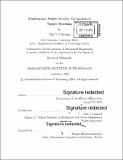Underwater multi-vehicle co-operative target-tracking
Author(s)
Cheung, Mei Yi,Ph. D.Massachusetts Institute of Technology.
Download1139336411-MIT.pdf (28.30Mb)
Other Contributors
Massachusetts Institute of Technology. Department of Mechanical Engineering.
Advisor
John J. Leonard.
Terms of use
Metadata
Show full item recordAbstract
The marine domain is fundamentally challenging for collaborative, multi-robot sensing and tracking operations. Accurate mapping and modeling of an underwater environment is both time consuming and difficult, especially when robots have limited access to a high-quality localization solution such as GPS. Communications over distances greater than one hundred meters necessitates the use of acoustics (acomms), which introduces networking challenges such as limited throughput and bandwidth. Successful execution of a highly dynamic and co-operative task such as target-tracking requires optimization of the information-gathering process, probabilistic inference over disparate, noisy sensor data, and exchange of local information over a costly communication link. This thesis presents two formulations of the co-operative underwater target-tracking task: a dynamic nonlinear sigma-point joint estimator and a non-Gaussian, non-parametric, multi-modal factor graph formulation of SLAM. Within the field of SLAM simultaneous estimation of a robot's state (localization) and modeling of its environment (mapping), there is a wealth of research into approaches using point estimate representations and Gaussian sensor noise. The marine domain presents two challenges not well addressed by the usual formulation: (1) measurements obtained from diverse sensors often require extensive filtering and parametrization to fuse in a Gaussian syntax and (2) acomms between multiple robots significantly limits the amount of local information that can be shared over the network. The non-Gaussian approach presented here utilizes the technique of synthetic aperture sonar (SAS) to relate disparate acoustic measurements in a consistent probabilistic framework. Experimental results under real-world acoustic conditions are gathered onboard our custom-built lightweight and low-cost ASVs in the Charles River, and detailed design specifications are presented for our testbed robots.
Description
Thesis: Ph. D., Massachusetts Institute of Technology, Department of Mechanical Engineering, 2019 Cataloged from PDF version of thesis. Includes bibliographical references (pages 215-231).
Date issued
2019Department
Massachusetts Institute of Technology. Department of Mechanical EngineeringPublisher
Massachusetts Institute of Technology
Keywords
Mechanical Engineering.